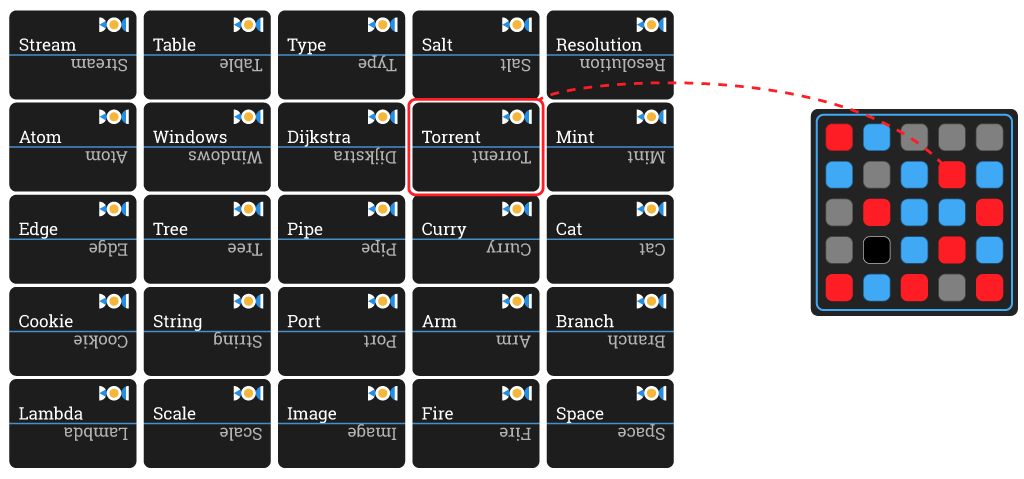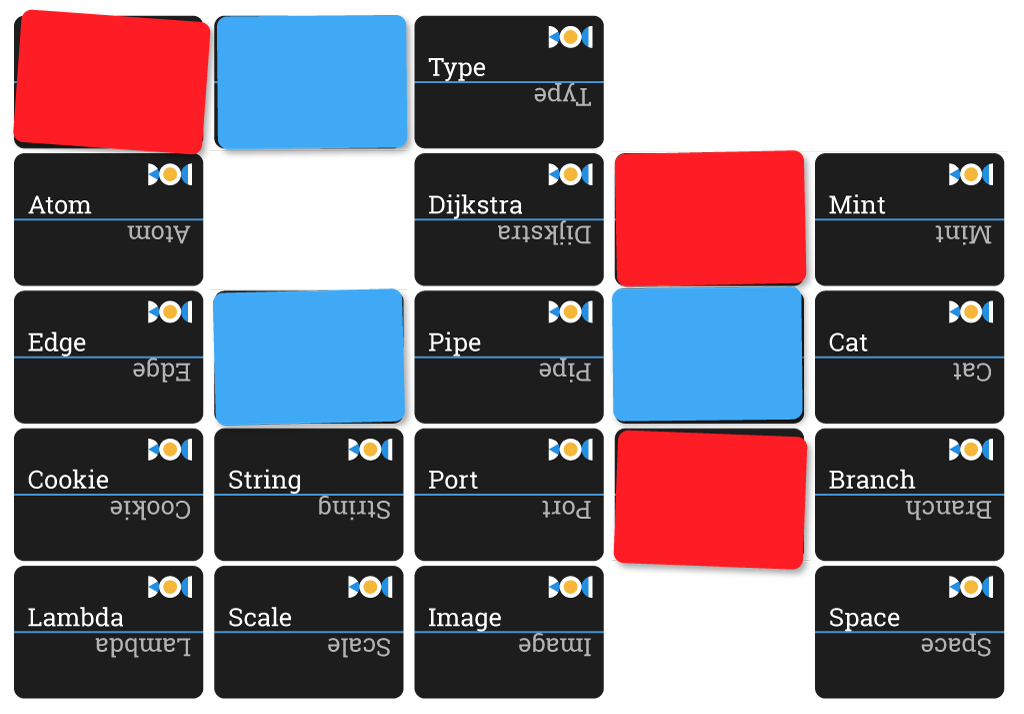Codenames
BOI Edition
- 1 rule card with a link to this page
- 8 colored cards for the blue teams
- 8 colored cards for the red team
- 1 card with one blue side and one red side
- 1 black assassin card
- 45 word cards
- 8 red tiles or 9 if the red team is the starting team.
- 8 blue tiles or 9 if the blue team is the starting team.
- 7 gray civilian tiles.
- 1 black assassin tile.
- The spymaster gives his or her team a clue, for example “Water 3”
- The rest of the team discuss and determine that the most likely word is “Stream”
- One person in the team then explicitly touches that card on the board
- The spymaster for the other team then chosen the appropriate colored card (red, blue, the black assassin card) and places it on the card. If the word instead was a civilian then the spymaster instead removes that card from the board.
- If a civilian word was picked. The turn for the current team ends immediately and it becomes the other team’s spymaster’s turn to come up with a clue.
- If a word was picked that was on the opponent’s team, then the colored card is placed on top of it as usual and the current team’s turn ends.
- If a word was picked that was the same color as the current team, then the team may continue to guess another time, up to a maximum of 1 more than the number given by the spymaster as part of the clue.
- If the assassin was picked then the team loses the game immediately. So the spymaster has to be very sure that his or her teammates will not associate a clue with that word.
- The blue spymaster starts and gives the clue “Cooking 3”
- The rest of the blue team quickly picks out “Curry”, which the red spymaster reveals is a blue word, so they get another guess.
- They guess “Salt” as the next one, which is also correct. As the third guess they guess “Cookie” which has a gray color, so it is removed from the board and the blue team’s turn ends. The spymaster wanted them to pick “Fire”.
- The red spymaster gives the clue “Character 3”
- The red red team looks over the words and sees 4 words that may be related: “Lambda” (as in the character ‘λ’), Space (as in the character ‘ ‘) and Pipe (as in the ‘|’ character) as well as String (which is a sequence of characters). However they think that Lambda, Space and Pipe are the most likely given that the spymaster said “Character” and not “Characters”. So they pick them one at a time and the blue spymaster reveals them one at a time as correct red words. Good thing they did because “String” is the assassin word, so this was a very risky clue. The red team then ends their turn voluntarily as they don’t have any more information to go on.
Overview
Codenames is a fun 4-8 player word based game. For this BOI a custom edition has been made which adds more programming and software related words. You should be able to find a copy of it in your backpack.
Codenames is a game with two teams, the blue team and the red team. There are also a set of 25 words openly displayed of which some belong to the red team and some to the blue team and some don’t belong to any team at all. However only a single person on each team know which words belong to which team and due to limited communication channels these two people, known as spymasters (the original Codenames game has some backstory which has been partly stripped from this edition), must give their team clues in order for them to be able to figure out which words are theirs. When all words for a given team have been picked then that team wins.
What’s included in the box
The game includes:
Setup
Divide your group into a red team and a blue team, each team then decides which one of them is going to be the spymaster. Ensure that the spymasters are seated next to each other as they will later have to look at a common piece of information that should not be shared with the rest of the team members. Take 25 random word cards from the pile and place them in a 5x5 grid on the table.

An example of a codenames board
Generate a new spymaster board using the javascript module right below this text. In contrast to the original Codenames game which had a limited number of physical cards for this purpose, this edition of the game has an online generator to provide even more combinations.
The spymasters’ colored card shows the type of each card on the table as well as the team which starts. The starting team’s color is indicated with a blue or red outline around the whole card. There are 4 different types of colors:
It is recommended that the spymasters’ pull up the website on e.g. a smartphone and position it in front of them during the game to quickly be able to see which words have which colors.
Place the blue and red cards as well as the assassin card in their own respective piles near the spymasters, the team which starts takes the card which is blue on one side and red on the other.

A codenames board with a spymaster card
How to play
Each team’s spymaster takes turn giving clues with the starting team indicated by a colored outline on the spymaster’s cards. On a team’s turn the spymaster has the task of formulating a clue consisting of a single word to give to his or her team as well as a number which should indicate which how many cards this clue refers to. When a clue has been given, the rest of the team have to discuss and guess which words that the spymaster referred to. Guessing is carried out in the following way:
This continues until all words for one of the teams have been picked, at which point that team is the winner, or the assassin is picked, at which point the team who picked the assassin immediately loses. If a team does not manage to pick all words that the spymaster meant for them to pick in a single turn, the team may use this clue as additional information in future turns. This is usually where the extra 1 guess per clue comes in.
The spymasters should remain silent on any matter relating to the words and clues except when actually giving their teams clues.

State of a game after a few turns.
Allowed clues
A clue consists of a single word or a (not made up) name. Furthermore the clue may not contain any word on the board (that hasn’t been picked) as a substring, nor may it be a substring of any word on the board. For example if one of the words on the board is “Block” then “Blockchain” is not a valid clue. Similarly if “Stack Overflow” is a word on the board, then “Overflow” or even “Flow” are not valid clues. A clue may not refer to the spelling of a word. For example if the words “Block”, “Bug” and “Break” are on the board then “Beta” may not be used as a clue if the intention is to indicate all words beginning with a “B”. Teammates may not ask the spymaster for the spelling or meaning of the clue. The spelling is sometimes important not to specify as the spymaster may want to use a homophone as a clue, i.e. words which sound the same but have different spellings. For example saying /ˈgriːs/ means both “Greece” as in the country, and “grease” as in a lubricant. The spymaster may however choose to specify the spelling when giving the clue. It is also not allowed to refer to the words position on the board. For example using the clue “Left” to refer to the words on the left side of the board is not allowed.
Special rules
The spymaster may give the number 0 as part of the clue. This removes the upper limit on the number of guesses and allows the team to guess an unlimited number of times given that they only pick words from their own team’s color. This is generally used to mean “these words are not ours”. Which is useful in some cases near the end of the game or to discourage the team from picking a particular set of words.
The spymaster may also say “unlimited” instead of a number. As with the number 0, this allows an unlimited number of guesses for the team. This may for example be used near the end of the game when the team knows a number of words for their team because of earlier clues, and the spymaster wants to allow them to pick all of them at once.
Example game
Let’s say we have the following words and spymaster card:



And so the game continues.
Frequently Asked Questions
Can the team only pick words related to the current clue, or can they use information from earlier clues that they failed to pick all words for?
Any word may be picked at any time. Using information from earlier clues is encouraged.
What if the spymaster is not sure if a word is allowed?
The spymaster may ask the other team’s spymaster in private, and they will have to agree on if it can be used or not.
What if a spymaster gives an invalid clue?
Then it is up to the other spymaster to come up with an appropriate punishment.
